Mammals
by
Christopher Baker
Home : Travel : Costa Rica : CR Handbook : One Article
Given the rich diversity of Costa Rica's ecosystems, it may come as a
surprise that there are only 200 mammal species in the nation, half of which
are bats. And Costa Rica, like most neotropical countries, has "a depauperate
marine mammal flora," in the words of one biologist. Several species of
dolphins and seven species of whales are common in Costa Rican waters, but
there are no seals. And the only endemic species of any significance is the
endangered manatee.
Before man hunted them to extinction, there were many more mammal
species. Even today all large and many small mammal populations are subject to
extreme hunting pressure or habitat destruction, and it is only recently that
large-mammal populations in the national parks are beginning to recover. Like
most large mammals, jaguars and tapirs are shy and stay well clear of people.
Sighting one would be cause for great celebration! Still, most visitors can
expect to see one or more species of monkeys, one of Costa Rica's four
ecologically unique tropical mammals; the others are sloths, anteaters, and
noninsectivorous bats. And luck, patience, and the aid of a professional guide
can lead to thrilling encounters with other species.
Early morning and late afternoon are the best times for wildlife
viewing, particularly around waterholes (the dry regions of Guanacaste offer
prime locations). I recommend joining a natural-history tour or guided
day-tours through one of the many tour companies specializing in wildlife
programs (see p. 142).
MONKEYS
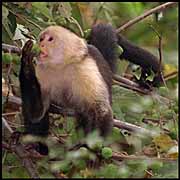 No visit to Costa Rica would be complete without seeing any of its four
species of monkeys: the cebus (or capuchin), howler, spider, and squirrel.
Along with approximately 50 other species, they belong to a group called New
World monkeys, which evolved from a single simian group that appeared about 40
million years ago in Africa and Asia. Some of these early primates migrated to
North America and then down the land bridge to Central and South America.
No visit to Costa Rica would be complete without seeing any of its four
species of monkeys: the cebus (or capuchin), howler, spider, and squirrel.
Along with approximately 50 other species, they belong to a group called New
World monkeys, which evolved from a single simian group that appeared about 40
million years ago in Africa and Asia. Some of these early primates migrated to
North America and then down the land bridge to Central and South America.
Though the North American monkeys gradually died out, their
southern cousins flourished and evolved along lines that differ markedly from
those of their ancestors in the Old World. While African and Asian monkeys have
narrow noses with nostrils that point down (much like human noses), New World
monkeys evolved broad, widely spaced nostrils. New World females, too, evolved
a singular ability to bear twins. And, perhaps most importantly, some New World
species--notably the cebus, howler, and spider monkeys--developed long
prehensile tails for added purchase and balance in the high treetops.
They inhabit a wide range of habitats, from the rainforest canopy
to the scrubby undergrowth of the dry forests, though each species occupies its
own niche and the species seldom meet. Together, they are the liveliest and
most vocal jungle tenants. Beyond the reach of most predators, they have little
inhibition about announcing their presence with their roughhousing and howls,
chatterings, and screeches. The sudden explosive roar of the howler monkey--a
sound guaranteed to make your hair stand on end!--is said to be the loudest
sound in the animal kingdom.
Capuchins
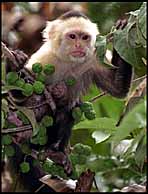 The distinctive-looking capuchin is the smartest and most inquisitive of
Central American simians. It derives its name from its black body and monklike
white cowl. If they look familiar to you, you've probably seen them dancing at
the end of a tether at street fairs in Europe or South America--they're the
little guys favored by organ-grinders worldwide. Capuchins range widely
throughout the wet lowland forests of the Caribbean coast and the deciduous dry
forests of the Pacific northwest below 1,500 meters. Two excellent places to
see them are Santa Rosa and Manuel Antonio national parks, where family troops
are constantly on the prowl, foraging widely through the treetops and over the
forest floor.
The distinctive-looking capuchin is the smartest and most inquisitive of
Central American simians. It derives its name from its black body and monklike
white cowl. If they look familiar to you, you've probably seen them dancing at
the end of a tether at street fairs in Europe or South America--they're the
little guys favored by organ-grinders worldwide. Capuchins range widely
throughout the wet lowland forests of the Caribbean coast and the deciduous dry
forests of the Pacific northwest below 1,500 meters. Two excellent places to
see them are Santa Rosa and Manuel Antonio national parks, where family troops
are constantly on the prowl, foraging widely through the treetops and over the
forest floor.
These opportunistic feeders are fun to watch as they search under
logs and leaves or tear off bark as they seek out insects and small lizards
soon after dawn and again in late afternoon. Capuchins also steal birds' eggs
and nestlings. Some crafty coastal residents, not content with grubs and insect
larvae, have developed a taste for oysters and other mollusks which they break
open on rocks. The frugal capuchin sometimes hoards his food for "rainy days."
While their taste is eclectic, they are fussy eaters: they'll
meticulously pick out grubs from fruit, which they test for ripeness by
smelling and squeezing. And capuchins are not averse to crop-raiding,
especially corn, as the farmers of Guanacaste will attest.
Squirrel Monkeys
The smallest Costa Rican primate, the squirrel monkey, or titi, is restricted
to the rainforests of the southern Pacific lowlands. Always on the go, day and
night, they scurry about in the jungle understory and forest floor on all
fours, where they are safe from raptor predators. Squirrels are more gregarious
than most other monkeys; bands of 30 individuals are not uncommon. Like the
larger capuchins, the titi is the arboreal goat of the forest. It will eat
almost anything: fruits, insects, small lizards. In times of abundance
(May-Oct.), the two species have been known to forage together. When food is
scarce they become rivals; the heftier capuchin invariably is the victor. The
titi is an endangered species.
Spider Monkeys
The large, loose-limbed spider monkey--the supreme acrobat of the forest--was
once the most widespread of the Central American monkeys. Unfortunately, they
are very sensitive to human intrusion and are among the first primate species
to decline with disturbance. The last few decades have see significant
destruction of squirrel monkey habitats, and land clearance and hunting--their
flesh is said to be very tasty--have greatly reduced spider monkey populations
throughout much of their former range. If you inadvertently come across them
you'll soon know it: they often rattle the branches and bark and screech loudly
to demonstrate their fearlessness.
These copper-colored acrobats can attain a length of a meter and a
half. They have evolved extreme specialization for a highly mobile arboreal
lifestyle. Long slender limbs allow spider monkeys to make spectacular leaps.
But the spider's greatest secret is its extraordinary prehensile tail, which is
longer than the combined length of its head and body. The underside is ridged
like a human fingerprint for added grip at the end of treetop leaps (it is even
sensitive enough for probing and picking). You might even see individuals
hanging like ripe fruit by their tail.
Gregarious by night (they often bed down in heaps), by day they are
among the most solitary of primates. The males stay aloof from the females.
While the latter tend to their young, which they carry on their backs, the
males are busy marking their territory with secretions from their chest
glands.
Howlers
The howler is the most abundant as well as the largest of central American
monkeys (it can weigh up to 10 pounds). It inhabits both lowland and montane
forests throughout Costa Rica. Fortunately, it is less sensitive to habitat
destruction than the spider monkey and can be found clinging precariously to
existence in many relic patches of forest.
While howlers are not particularly aggressive, they sure sound it!
The stentorian males greet each new day with reveille calls that seem more like
the explosive roars of lions than those of small arboreal leaf-eaters. The
hair-raising vocalizations can carry for almost a mile in even the densest of
jungle. The males sing in chorus again at dusk (or whenever trespassers get too
close) as a spacing mechanism to keep rivals at a safe distance. Their
Pavarotti-like vocal abilities are due to an unusually large larynx and throats
that inflate into resonating balloons. Females generally content themselves
with loud wails and groans--usually to signal distress or call a straying
infant. This noisy yet sedentary canopy browser feeds on leaves (64% of its
diet) and fruit. Although capable of eating anything that grows, howlers are
extremely selective feeders.
JAGUARS
Worshiped as a god in pre-Columbian civilizations, the jaguar is the
symbol of the Central American jungle. Panthera onca was once especially
abundant in the dense forests, coastal mangroves, and lowland savannahs of
Central America. Today, sadly, this magnificent and noble beast is an
endangered species, rare except in parts of the larger reserves: Santa Rosa,
Tortuguero, Corcovado National Park, the Río Macho Forest Preserve, and
lower levels of the Cordillera Talamanca.
While a few of the famous black "panther" variety exist, most
Central American jaguars are a rich yellow, spotted with large black rosettes.
Jaguars are the largest and most powerful of the American members of the cat
family--a mature jaguar measures more than seven feet long, stands two feet at
the shoulders, and weighs up to 200 pounds. The animal's head and shoulders are
massive, the legs relatively short and thick. An adept climber and swimmer, the
beast is a versatile hunter, at home in trees, on ground, and even in water.
Not surprisingly, it feeds on a wide range of arboreal, terrestrial, and
aquatic animals and is powerful enough to kill a full-grown cow.
Don't be surprised if you come across a jaguar's footprints
alongside a mangrove islet or streambed in the gallery forest. Don't get your
hopes up, however. You're not likely to see one lying lazily by the riverbank
(a favorite pastime), one paw dangling in the water, as it waits to flip out a
passing fish or turtle.
Although one source states that they seem not to avoid the scent of
man and may follow a man walking a trail, most agree that jaguars are extremely
shy creatures, not particularly dangerous, and attack humans very rarely.
Although jaguars are legally protected and spotted cat trophies cannot be
imported into the U.S., hunting may still occur. However, the main threat to
the remaining jaguar population is deforestation. When roads penetrate the
primeval forest, the jaguar is among the first large mammals to disappear.
SLOTHS
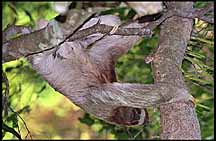 Ask anyone to compile a list of the world's strangest creatures and the
sloth would be right up there with the duck-billed platypus. And while the
creature moves with the grace and deliberation of a tai chi master, few would
argue about the beast's ugly looks. The sloth, which grows to about the size of
a medium-sized dog, has a small head and flat face with snub nose, beady eyes,
and rudimentary ears (its hearing is reputedly so poor that one can fire a gun
within inches and its only response will be a slow turn of the head). Its long,
bony arms are well-developed, however, with three curving claws which hook over
and grasp the branches from which it spends almost its entire life suspended
upside down.
Ask anyone to compile a list of the world's strangest creatures and the
sloth would be right up there with the duck-billed platypus. And while the
creature moves with the grace and deliberation of a tai chi master, few would
argue about the beast's ugly looks. The sloth, which grows to about the size of
a medium-sized dog, has a small head and flat face with snub nose, beady eyes,
and rudimentary ears (its hearing is reputedly so poor that one can fire a gun
within inches and its only response will be a slow turn of the head). Its long,
bony arms are well-developed, however, with three curving claws which hook over
and grasp the branches from which it spends almost its entire life suspended
upside down.
The arboreal beast pays no attention to personal hygiene. Its
shaggy fur harbors algae and mold that make the sloth greenly
inconspicuous--wonderful camouflage from prowling jaguars and keen-eyed eagles,
its chief predators. Hordes of mites, beetles, and caterpillars graze on its
moldy hair. And the sloth even has communities of parasitic moths that live in
the depths of its fur.
Lulled by its relative treetop security, the sloth, says naturalist
David Attenborough, "has sunken into an existence just short of complete
torpor." The creature spends up to 18 hours daily sleeping curled up with its
feet drawn close together and the head tucked between the forelimbs. Actually,
Costa Rica has two species of sloths: the three-toed sloth (Bradypus
variegatus) and the nocturnal two-toed sloth (Choloepus hoffmani).
You're more likely to see Bradypus, which is active by day.
At top speed a sloth can barely cover a mile in four hours. On the
ground, it is even more awkward and crawls with great difficulty or simply
falls on the ground. In fact, there's a very good reason sloths move at a rate
barely distinguishable from rigor mortis.
A sloth's digestion works as slowly as its other bodily functions.
Its metabolic rate is half that of other animals of similar size, and food
remains in its stomach for up to a week. Hence, it has evolved a large
ruminantlike stomach and intestinal tract to process large quantities of
relatively indigestible food. To compensate, it has sacrificed heavy muscle
mass--and, hence, mobility--to maximize body size in proportion to weight.
Thus, the sloth has evolved as a compromise between a creature large enough to
store and process large quantities of food and one light enough to move about
in trees without breaking the branches.
When nature calls (about once a week), the animal descends to
ground level, where it digs a small hole with its hind limbs. It then shits
into the depression, urinates, covers the broth with leaves, and returns much
relieved to its arboreal life. During this 30-minute period, the female "sloth
moths" have been busy laying their eggs on the sloth dung. When hatched, the
larvae feed and pulpate on the feces. The newly emerged adults then fly off to
seek a new sloth.
Sloths, which may live up to 20 years or longer, reach sexual
maturity at three years, a relatively old age for mammals of their size.
Females give birth once a year (the gestation period is about six months) and
spend half their adult lives pregnant. Although female sloths are never
separated by choice from their offspring, they are peculiarly unsentimental
about their young: if a baby tumbles, its plaintive distress calls go unheeded.
And when the juvenile reaches six months old, the mother simply turns tail on
her youngster, which inherits her "home range" of trees.
An easy way to find sloths is to look up into the green foliage of
cecropia trees, which form one of the sloth's favorite food staples. More
adventurous individuals might even be seen basking in the sunlight, feigning
dead halfway up a tree. The sloth's heavy fur coat provides excellent
insulation against heat loss. Still, its body temperature drops almost to the
temperature of its surroundings at night and, much like cold-blooded reptiles,
the sloth needs to take in the sun's rays to bring its temperature to normal
mammalian levels. The sight of a sloth languishing in open cecropia crowns is a
heavenly vision to harpy eagles, which swoop in to snatch the torpid creature
much like plucking ripe fruit.
TAPIRS
Another symbol of the New World tropics is the strange-looking tapir, a
solitary, ground-living, plant-eating, forest-dwelling, ungainly mixture of
elephant, rhinoceros, pig, and horse. The tapir uses its short, highly mobile
proboscis--an evolutionary forerunner to the trunk of the elephant--for
plucking leaves and shoveling them into its mouth. This endangered species is
the largest indigenous terrestrial land mammal in Central America. Like its
natural predator the jaguar, the tapir has suffered severely at the hands of
man. The animal was common in Costa Rica and ranged far and wide in the lowland
swamps and forests. It was even present in the bamboo thickets up to 3,000
meters elevation in the Talamanca Mountains. Hunters have brought it to the
edge of extinction.
Today, tapirs are found only in national parks and reserves where
hunting is restricted, with the greatest density in Corcovado National Park,
which has a population of fewer than 300. They have learned to be wary of man,
and few travelers have the privilege of sighting them in the wild. Tapirs live
in dense forests and swamps and rely on concealment for defense. They are
generally found wallowing up to their knees in swampy waters. In fact, tapirs
are rarely seen far from water, to which they rush precipitously at the first
sign of danger. The tapir's speed--in the forest it can run as fast as a man in
the open--is no protection from hunters. The animals make conspicuous trails in
the forest, and because tapirs maintain territories which they mark with dung
or scent, they are easily tracked by dogs.
OTHER MAMMALS
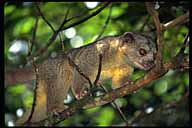 The most commonly seen mammal is the agouti, a large rodent
related to the guinea pig, which looks like a giant tailless squirrel. Its
nocturnal cousin, the paca, is a favorite of hunters. Both are easily
captured due to the strong anal musks they use to scent their territories and
to their habit of running in circles but never leaving their home turf (pacas,
at least, are intelligent enough to leap into water and stay submerged for a
considerable time). If you disturb one in the forest, you may hear its
high-pitched alarm bark before you see it.
The most commonly seen mammal is the agouti, a large rodent
related to the guinea pig, which looks like a giant tailless squirrel. Its
nocturnal cousin, the paca, is a favorite of hunters. Both are easily
captured due to the strong anal musks they use to scent their territories and
to their habit of running in circles but never leaving their home turf (pacas,
at least, are intelligent enough to leap into water and stay submerged for a
considerable time). If you disturb one in the forest, you may hear its
high-pitched alarm bark before you see it.
Anteaters, too, are common in lowland and middle-elevation
habitats throughout Costa Rica. These are the squirrel-sized, tree-dwelling
kind called tamanduas. The giant terrestrial anteater, with its huge, bushy
tail, is now restricted to the less sparsely forested areas of the Osa
Peninsula. At night you may, with a great deal of luck, also see the strictly
arboreal silky anteater, which can hang from its strong prehensile tail.
Anteaters are purists and subsist solely on a diet of ants and termites, plus a
few unavoidable bits of dirt. There is no doubt about what the best tool is for
the job--a long, sticky tongue. The anteater's toothless jaw is one long tube.
When it feeds, its thong of a tongue flicks in and out of its tiny mouth,
running deep into the galleries of excavated ant and termite nests. Each time
it withdraws, it brings with it a load of ants, which are scraped off inside
the tunnel of its mouth and swallowed, to be ground down by small quantities of
sand and gravel in its stomach.
Another endearing and commonly seen mammal is the long-nosed
coati, the most diurnal member of the raccoon family, found throughout
the country. Coatis wear many coats, from yellow to deepest brown, though all
are distinguished by their faintly ringed tail, white-tipped black snout, and
pandalike eye-rings. The animal is at home both on the ground and in the
treetops, where it can sometimes be spotted moving from tree to tree. (The name
coatimundi refers specifically to lone coatis; the animals are usually
gregarious critters.)
Another charming member of the raccoon family is the small and
totally nocturnal kinkajou, with its large limpid eyes and velvet-soft
coat of golden brown. It's a superb climber and spends most of its life feeding
on fruit, honey, and insects in the treetops. By day it is very drowsy; if
picked up, its first instinct is to cuddle against your chest, bury its head to
avoid the light, and drop back off to sleep.
The sleek, long-haired chocolate-brown tayra--a meter-long
giant of the weasel family--is often seen in highland habitats throughout Costa
Rica. Weighing up to 10 pounds, the tayra habitually preys on rodents but can
make quick work of small deer. Keep an eye off the ground, too, particularly in
Santa Rosa National Park, where they can sometimes be seen stalking squirrels
in the crowns of deciduous trees with a motion so fluid they seem to move like
snakes.
Manatees
Anyone venturing to Tortuguero National Park will no doubt be hopeful of seeing
a West Indian manatee. This herbivorous marine mammal has long been hunted for
its flesh, which is supposedly tender and delicious, and for its very tough
hide, once used for machine belts and high-pressure hoses. The heavily wrinkled
beast looks like a tuskless walrus, with small round eyes, fleshy lips that
hang over the sides of its mouth, and no hind limbs, just a large, flat,
spatulate tail. Now endangered throughout their former range, these creatures
once inhabited brackish rivers and lagoons along the whole coast of Central
America's Caribbean shoreline. Today, only a few remain in the most southerly
waters of the U.S. and isolated pockets of Central America. Tortuguero, where
the animals are legally protected, has one of the few significant populations.
They are not easy to spot, for they lie submerged with only the nostrils
showing. Watch for rising bubbles in the water: manatees suffer from
flatulence, a result of eating up to 100 pounds of water hyacinths and other
aquatic flora daily. Good fortune may even provide an encounter with groups of
manatees engaged in courtship ritual. Interestingly, the manatee is one of very
few species in which males are known to engage in homosexual activity.
Bats
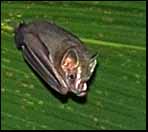 It won't take you long to discover that the most numerous mammals by far are
the bats, found throughout Costa Rica. You may easily come across them
slumbering by day halfway up a tree or roosting in a shed. In true Dracula
fashion, most bats are lunarphobic: they avoid the bright light. On nights one
week before and after the full moon, they suspend foraging completely and stay
in their roosts while the moon is at its peak.
It won't take you long to discover that the most numerous mammals by far are
the bats, found throughout Costa Rica. You may easily come across them
slumbering by day halfway up a tree or roosting in a shed. In true Dracula
fashion, most bats are lunarphobic: they avoid the bright light. On nights one
week before and after the full moon, they suspend foraging completely and stay
in their roosts while the moon is at its peak.
Many bat species look more grotesque than any painted demon in a
medieval manuscript. Most of these--like the giant Jamaican fruit bat,
with a wingspan of more than 20 inches--are frugivores (fruit eaters) or
insectivores, and quite harmless.
The vampire bats are a different matter: they inflict an
estimated $100 million of damage on domestic farm animals throughout Central
and South America by transmitting rabies and other diseases. The vampire bat's
modus operandi is almost as frightening as the stuff of Bram Stoker's
Dracula. It lands on or close to a sleeping mammal, such as a cow or,
yes, even an unsuspecting human. Using its two razor-sharp incisors, it then
punctures the unsuspecting beast and, with the aid of an anticoagulant saliva,
merrily squats beside the wound and laps up the blood while it flows.
The most interesting of bats, however, and one easily seen in
Tortuguero, is the fishing bulldog bat, with its huge wingspan (up to
two feet across) and great gaff-shaped claws with which it hooks fish. It
fishes by sonar. Skimming the water surface it is able to detect slight ripples
ahead. The bat then drops its hooked feet at just the right moment and--hey
presto!--supper.
philg@mit.edu
 No visit to Costa Rica would be complete without seeing any of its four
species of monkeys: the cebus (or capuchin), howler, spider, and squirrel.
Along with approximately 50 other species, they belong to a group called New
World monkeys, which evolved from a single simian group that appeared about 40
million years ago in Africa and Asia. Some of these early primates migrated to
North America and then down the land bridge to Central and South America.
No visit to Costa Rica would be complete without seeing any of its four
species of monkeys: the cebus (or capuchin), howler, spider, and squirrel.
Along with approximately 50 other species, they belong to a group called New
World monkeys, which evolved from a single simian group that appeared about 40
million years ago in Africa and Asia. Some of these early primates migrated to
North America and then down the land bridge to Central and South America.


